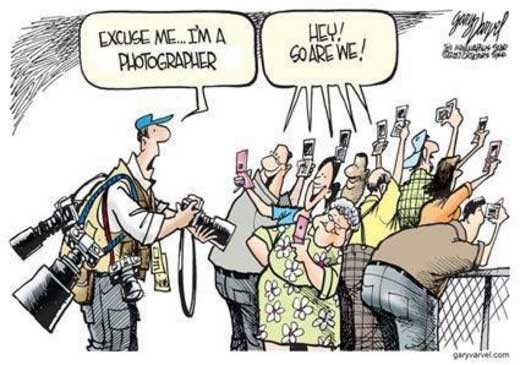There is more to the story than just capturing the image.
Here is a picture that has being shared around social outlets, especially among my broadcast journalist colleagues. When I look at this funny little caricature, I am amused by the technological indicator of where we are as consumers, and how we have become a part of reporting the story.
If you look at the picture…ten years ago, you could flip flop this image. The paid photojournalists were on the right and the lay person was on the left wondering what is going on. Now, even our grandmother’s have access to smartphones that capture and record high quality images and video. They even have access to technology like Twitter, Facebook, Flickr, Instagram, YouTube, and a host of other technologies that have larger audiences than a television stations DMA.
It is funny how times are shifting and we as storytellers are having to learn to compete in a space flooded with “that” proliferation of information. It is a new paradigm and it is hard not to get scared of this digital media industry. We as practitioners are trying to find ways to bring value to the craft of photojournalism, digital communication, and documentary storytelling…and separate ourselves in this competitive world of “media.”
I was sharing this photo with a close friend and he asked, “Does this photo make you wonder if there is a timeframe to your industry?” I actually feel it strengthens my mission and my business. There is a distinction between the technology that captures and shares images and the craft of using media to tell stories. It is a difference between the practitioner and the technician.
I am excited to let the community act as the technician with their iPhones and Droids and using their 4G LTE service to share those images. Why? Because I can allow them to share the information and let me tell the story behind the information.
The craft behind storytelling allows “us” to use media(s) to capture, craft, construct, and share a story with an audience…inspiring them to create change. Let’s take the Tsunami in Japan, so many individuals captured this story in real time with their smartphones and share online. The storytellers were the individuals that found the people directly impacted by that wall of water…crafted stories that share the human element of this story. Those are the stories that still grip us and bring context to those images.
Both communities (practitioners and technicians) co-exist and leverage each other’s digital access…the consumer shares the action and the storytellers craft the human element of the reaction.
* Image by Gary Varvel


One comment